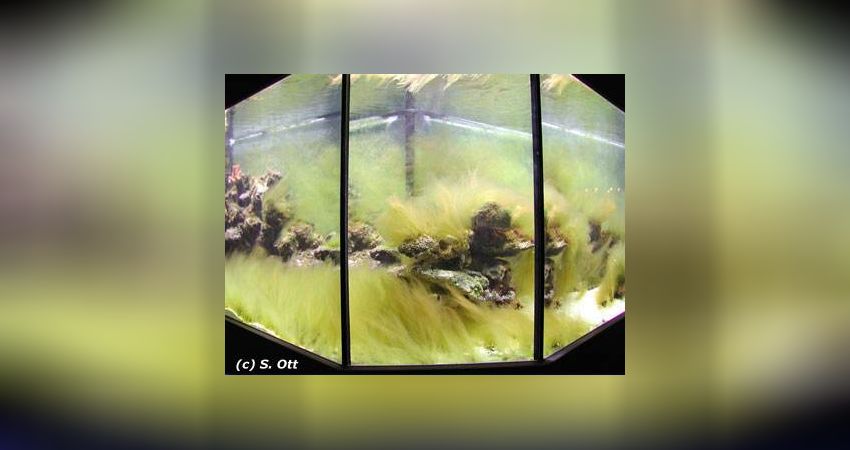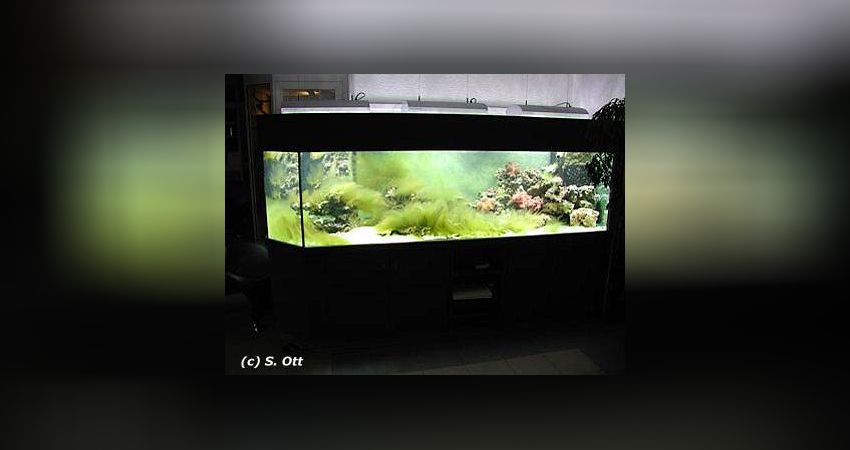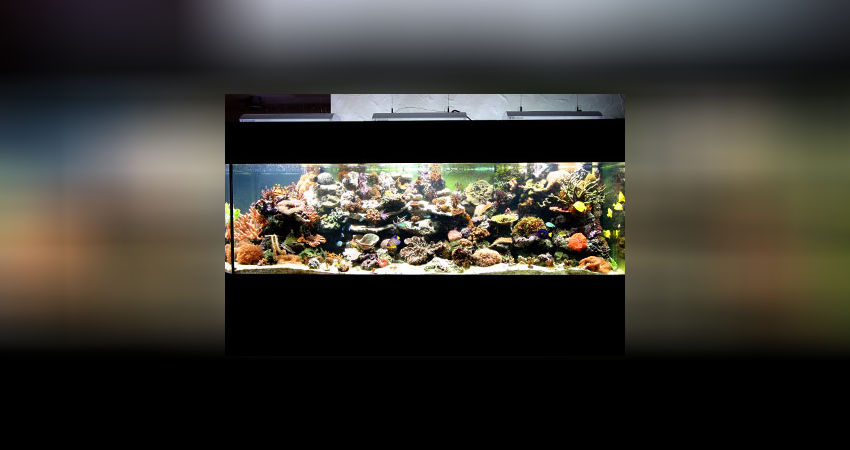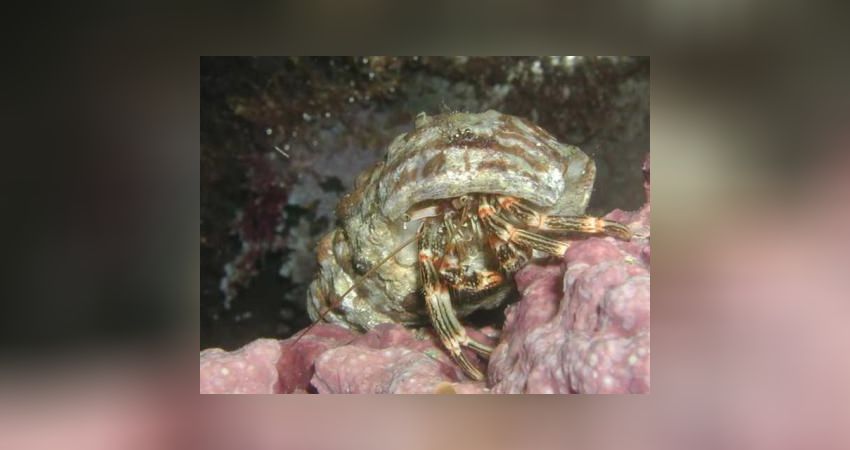12 - Start-up phase of a saltwater aquarium

heftig aber durchaus normal
Now it's time for the aquarium to really get going. Everything about diatoms and filamentous algae and why this is usually part of it. Now the patience phase begins
The start-up phase of a reef aquarium:
Now that the stone structure and substrate have been placed in the aquarium, you still have time to complete the stone structure. After this, the so-called run-in phase begins for reef aquarists. Many, especially newcomers, will not have much idea of what this term means at first. This term describes the first weeks after the first live stones have been introduced.
During this time, the whole biology goes haywire and gradually comes to its senses. Most of the living stones come from far away, and are therefore first of all a burden for the still relatively fresh, partly still aggressive salt water. The reason for this is that most of the bacteria in the stones, which are sent damp in polystyrene boxes and are sometimes on the move for two days, have died off, or do so in the first few days in the aquarium. But not so bad, although the quality of the rock used is very important. The rock should not smell bad, otherwise we would not use it at all. Good rock smells like the sea! In addition to the bacteria dying off, the swarm and other animals that have come along on the stones also die off. Make sure to remove dead animals from the stones. But beware, there are plenty of invertebrates that will catch and survive in the aquarium. Nevertheless, you should pay particular attention to rotting sponges and the like and remove them.
We consider it sensible to start stocking live stones approx. 3 - 6 days after the saltwater has run in. If you can let your water run in for a longer period of time, for example in suitable containers, you should do this. Nevertheless, we consider the quality of the salt brands used today to be so good that after a while you can dare to use the stones. Treat the stones like living animals, after all they cost enough.
Once again the authors would like to point out that porous living rock is the better choice, as the important bacteria form more quickly here than in less porous rock!
A long-time aquarist gave one of the authors the tip 12 years ago to add just a little substrate, maybe even a live stone from a long-running aquarium. You wouldn't believe how many bacteria you introduce into the new tank. This is called "inoculating the tank" and has the advantage that it usually makes it easier to start the tank. It is not only about the bacteria, but also about the micro-organisms that are in the substrate. Since dead sand is usually used, the micro-organisms introduced will take possession of the new, still clean biotope and multiply slowly but steadily.
Since not every start-up phase is the same, the authors cannot give a generally valid recommendation here, but they do try to describe what will happen in most cases.
Diesel algae growth:
After the stones and substrate have been added and the aquarium has been started, diatoms will usually start to grow. This äussert itself by brown unschöne Beläge on the ground. Don't worry, this is normal. They are among the first colonisers. These brown diatoms diminish over time due to the absorption of silicate and become less. If you have used tap water instead of ultrapure water, it may take a little longer for this to disappear. However, silicate additives are available from the trade, and you should not hesitate to add something if the growth is strong and the silicate values are high. This phase can be over quickly, or even last for weeks.
Grünalgae growth:
With the growth of the diatoms, growth also begins on the stones that have been used. These are mostly filamentous algae, which are also not desirable and amount to a nuisance. In addition, there is certainly the growth of other species that you have brought into the tank through the stones. Today we would advise the use of higher algae, called Caulpera. These compete directly with the filamentous algae for food and are thus usually easier to control.
heftig aber durchaus normal
Fadenalgenblüte
In these phases, exactly what the authors described in the chapter Biological filtration is true. There is an increase in ammonia, nitrite and subsequently nitrate. However, this is quite normal as the bacteria are only formed afterwards. It would be detrimental to the entire start-up phase if fish were already introduced here. On the one hand, there is not yet a stable environment, and on the other hand, they put too much strain on the biology of the aquarium that is just being created. In this phase, measuring the water parameters, especially ammonia, nitrite and nitrate, is quite interesting, although not really necessary. The measurements only become important with increasing algae decline and the approach of the day of the first animals.
.das selbe Aquarium :-)
Water tests:
Water tests are important, it usually doesn't work without them. You certainly don't need to measure a well-running aquarium all the time, but you should do so from time to time. The most important parameters here are:
ammonia (only at the beginning or if something is visibly wrong in the tank with the animals)
nitrite (also only at the beginning, or if something is wrong)
nitrate (should be measured at least every fortnight to be able to react if necessary). (should be measured at least every two weeks to be able to react if necessary)
Phosphate (like nitrate)
Calcium (should be measured weekly)
Magnesium (here it is sufficient to measure once a month, this value is often quite stable for a long time)
PH (important at the beginning, but later hardly any aquarists measure it)
Nitrites (also only at the beginning or if something is not right);Conductivity, salt density (should also be measured more often)
Silicate (only important if you have a problem with silica)
The authors try to do without company advertising, but especially in the sector of water tests it is not possible. Over the years, Korallenriff.de has carried out a series of elaborate tests, but in the end there are hardly any water tests that provide really accurate results. You will find some helpful links on www.korallenriff.de in the section Reports General - Measurement and Rules. But be careful, experience shows that hardly any of the test candidates deliver solid and accurate results over a long period of time. Here, too, we would like to give you the tip to inform yourself in various internet boards on the subject of test accuracy. In many forums you can often find the latest results on water tests. After the short excursion on water chemistry, we will return to the further start-up phase.
Salinität:
Here the two authors have already written an extensive article that deals with density, salinity and conductivity. Since the salt content is very important in seawater, you should measure it more often. It seems very important to us to mention that only salt water evaporates and the salt remains in the aquarium. Regular water changes, which the authors consider to be the be-all and end-all of saltwater aquaristics, can prevent any salinisation. However, this requires regular measurement of the salinity. The article on salinity can be found in the Water Chemistry section.
The authors recommend stocking hermits and snails, i.e. real algae eaters, especially at the beginning after the first algae phase, provided the values are low, of course. These are not only useful but almost an important preventive measure against future algae growth.
nützliche Helfer: Einsiedler
Over the next few weeks, the growth of filamentous algae will slow down and, in most cases, stop. At this time, the red chalk algae that you have brought into the aquarium with the stones will start to grow. For the authors, this is the sign that the so-called start-up phase is coming to an end. Of course, this does not mean that you should put everything you want into the tank, but you can definitely think about stocking the first invertebrates or fish. However, we don't think much of immediately stocking the tank with fish, as this might upset the biology that has only just been established. After all, it takes a while for the bacteria in the aquarium to adjust to the stresses.
We hope to have helped some "advice seekers" with this small article. Once again, the authors would like to point out that every aquarium can develop differently and the statements made here do not always have to be exactly the same. There are many ways to reach the goal, which is especially true for marine aquaristics!
The most important sentence that one of the authors heard in the early days, it was in 1991, was "Leave your fingers out and the tank alone"! Taking this advice to heart has helped in most cases to this day.
Frank Diehl, Robert Baur-Kruppas
How do you like this article?
Info
Author

Bookmark
Comments
Topics
Similar articles
- Photographing under blue light - 4 clip filters in comparison
- How a marine aquarium is created Part 39: Montipora snails Phestilla sp.
- How a marine aquarium is created-Part 7: The light
- 12 - Start-up phase of a saltwater aquarium
- How a marine aquarium is created Part 34: Who eats our snails?
- 17 - Part 4 Filter systems - Berlin system
- How a marine aquarium is created-Part 18: Supply KH, calcium and magnesium
- 03 - Base unit/substructure:
- How a marine aquarium is created Part 47: The Armatus 400 after 30 months
- 27 - Angelfish in a community aquarium?
Comments To the top
Please register
In order to be able to write something yourself, you must register in advance.






